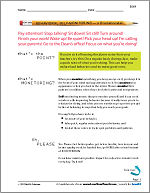Behavior Self-Monitoring
Printable guide

Click to download the printable guide
Video
Stop the hassles
Pay attention! Stop talking! Turn around! Sit down! Sit still! Pick your head up! Wake up! Be quiet! Focus!
Are you sick and tired of hearing these things all the time? You can probably reduce the amount of times you hear this sort of noise by monitoring your own behavior.
It's easy to do.
First, you and your teacher (or another adult) will come up with a couple of behaviors that you should be doing more. For example: paying attention in class, actively listening to the teacher, sitting still, and so on.
Then, every day in class, you'll fill out a quick sheet by checking off checkboxes at regular intervals.
At the end of class, you'll count up the checkboxes and keep track of the numbers over time. When you're successful at improving good behaviors (and reducing undesirable ones), your numbers will go up and your hassles will go down.
Step one: Pick a target behavior or two
The big idea here is: when good behaviors increase, bad behaviors decrease.
The first thing you have to do is pick a behavior or two (three at the most) that you want to increase. Always think about increasing desirable behaviors, not decreasing undesirable ones. In other words, don't say, "stop talking", say, "remain quiet." Don't say, "stop daydreaming", say "work productively."
Here are some examples of positive behaviors:
- looking at teacher
- awake and alert
- seated
- hands and feet still
- mouth closed, voice quiet
- actively listening to teacher
- working appropriately
- taking notes
- checking writing for correctness
- recording homework in daily planner
- (anything else that you want to see more of)
Step two: fill out the sheet every day
Print the Behavior Self-Monitoring Gradebooster (below). It has everything you need to monitor your behavior, including examples and the actual behavior self-monitoring sheet, on page 3. Print as many copies of page 3 as you need.
You may not want to do extra work, but the few minutes it will take you to do this every day is much, much less time than all the detentions and lectures you have to sit through now. Give it a shot – it usually works.
Step three: track your progress every day
Every day, you'll get a few numbers from the sheet which represent how well you're doing with improving your target behaviors. Keep track of these numbers every day, either in an electronic spreadsheet program, or by keeping the sheets and looking at your progress.
You'll probably be able to see a relationship between your numbers and what was going on in class each day. For example, you may have a more difficult time when it's time to write, or you may have a better time when it's time for a class discussion.
Over time, you'll start to get a better idea of what activities in class help or hurt your behaviors, and when you know yourself better like this, you're able to do a better job of controlling and improving your behavior.